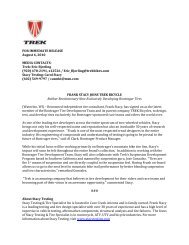Sensor Owner's Manual 1997 - Trek Bicycle Corporation
Sensor Owner's Manual 1997 - Trek Bicycle Corporation
Sensor Owner's Manual 1997 - Trek Bicycle Corporation
Create successful ePaper yourself
Turn your PDF publications into a flip-book with our unique Google optimized e-Paper software.
COMPUTER SET UP<br />
Battery Installation<br />
All Clear Button<br />
1. Remove the battery cover from the back<br />
side of the computer using a<br />
narrow flat blade screwdriver.<br />
2. Install the battery so that the<br />
positive "+" side of the battery is visible,<br />
and replace the battery cover.<br />
CAUTION: On the bottom of the computer<br />
head next to the battery door is a small<br />
recessed button. This is the Auto Clear<br />
Button. Pressing this button will clear all<br />
memories and reset all functions to their<br />
default values.<br />
BUTTON FUNCTIONS<br />
Mode Button<br />
Adjust<br />
Button<br />
The <strong>Sensor</strong> is equipped with 2 buttons that<br />
control the function of the unit.<br />
1. MODE<br />
Changes the Main Screens of the <strong>Sensor</strong><br />
2. ADJUST<br />
Adjusts digits while programming and<br />
activates ATM lap timer.<br />
PROGRAMMING YOUR TREK<br />
SENSOR CYCLE COMPUTER<br />
Setting the Clock<br />
1. Press the mode key to advance<br />
to MXS/Clock display.<br />
2. Press and hold the mode key for over 2<br />
seconds until hours setting<br />
begins to flash.<br />
3. Press the adjust key to adjust hours<br />
setting, press the mode key to confirm and<br />
advance to minutes setting.<br />
4. Press the adjust key (hold for fast<br />
advance) to adjust the minutes, and press<br />
the mode key to confirm setting and enter<br />
normal display mode.<br />
Setting Miles/ Kilometers and<br />
Wheel Size<br />
1. Press mode computer key to enter<br />
AVS/ODO mode.<br />
2. Press and hold mode key for over 2 seconds<br />
until m/h begins to flash.<br />
3. Press adjust key to select miles (m/h) or<br />
kilometers (km/h) display.<br />
4. Press mode key to confirm choice and<br />
advance to wheel size setting.<br />
5. Adjust the flashing digit with the adjust<br />
button, confirm choice by pressing mode<br />
button, and advance to next flashing digit.<br />
6. Adjust and/or confirm all flashing<br />
digits.<br />
Wheel Size Setting<br />
The wheel size setting number is equal to<br />
the distance, in millimeters, that your front<br />
wheel travels during one complete revolution.<br />
Each time the wheel magnet passes<br />
the sensor unit on your fork, the sensor<br />
sends an impulse to the computer telling it<br />
that your wheel has completed one revolution.<br />
The computer calculates this distance<br />
vs. time to give you accurate readings for<br />
the various modes.<br />
Determining Wheel Size Setting<br />
There are three methods for determining the<br />
wheel size setting. For the most accurate<br />
computer readings, it is best to measure the<br />
actual distance that your wheel travels in<br />
one complete revolution. This method is<br />
called a wheel roll out.<br />
Method One: Wheel Roll Out<br />
• Perform the wheel roll out on a hard,<br />
flat, smooth surface such as a garage or<br />
basement floor.<br />
• Make sure your tires are properly inflated.<br />
1. Position your bike so that the valve stem<br />
of the front wheel is at its bottom most<br />
position. Mark the spot on the floor directly<br />
under the center of the valve stem using a<br />
piece of tape or chalk.<br />
2. Roll the bicycle forward in a straight line,<br />
while putting downward pressure on the handlebars<br />
to simulate rider weight. When the<br />
wheel has completed one revolution and the<br />
valve stem is at its bottom position, mark the<br />
floor directly under the center of the valve<br />
stem with tape or chalk. Measure the distance<br />
between the two marks in millimeters. (Note:<br />
Conversion of in. to mm. is 1 in.=25.4 mm.)<br />
This is your wheel setting number. You can<br />
repeat this procedure and average your results.<br />
We recommend that you record your wheel setting<br />
numbers here for future reference.<br />
6 7

















